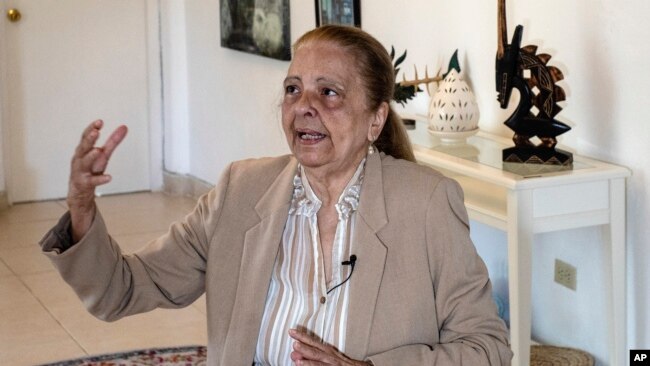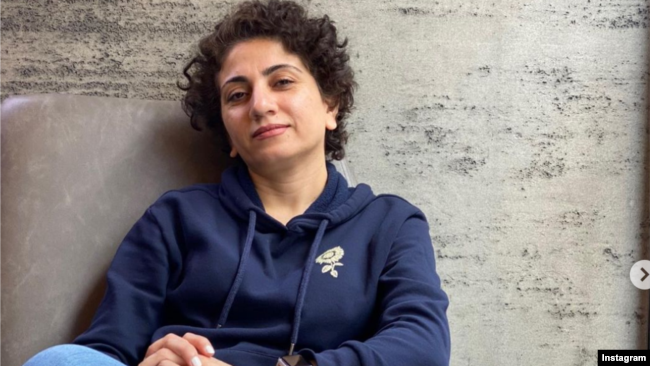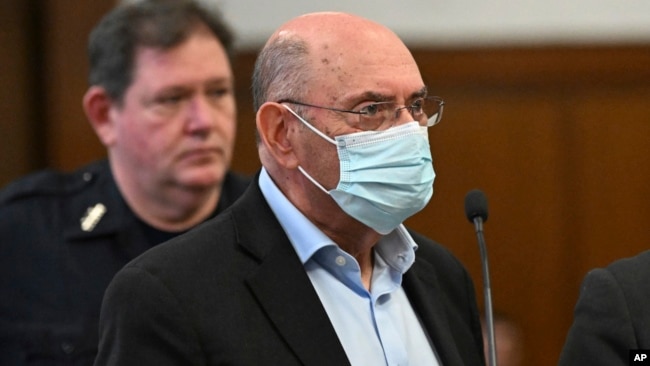한 세기 후에 멕시코의 획기적인 벽화를 부활시키세요
Reviving Mexico's Groundbreaking Muralism a Century Later
페이지 정보
작성자 Associated Press 작성일 22-08-13 03:00 댓글 0본문
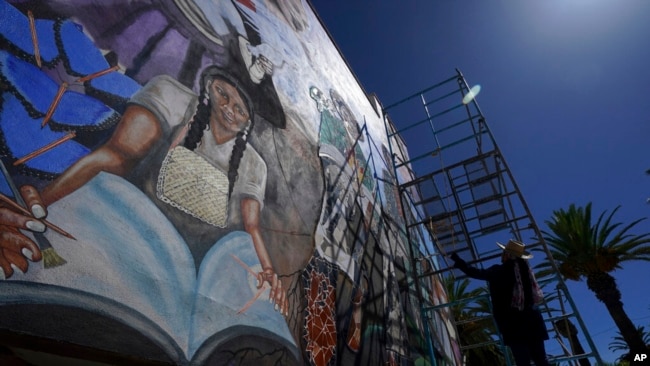
멕시코의 벽화가 Janet Calderon은 7월 멕시코 산살바도르에 있는 지방 건물의 정면에 그림을 그립니다.
Mexican mural artist Janet Calderon paints on the facade of a municipal building in San Salvador, Mexico, July 30, 2022.
폭스인데제, 멕시코-
POXINDEJE, MEXICO —
주황색 멜빵바지를 입은 화가가 소총을 들고 있는 손의 이미지를 손질하는 반면, 비계 위에 앉아 있는 화가는 게릴라 투사의 모자이크 안에 다채로운 도자기 조각들을 힘겹게 놓았습니다.
A painter in orange overalls touches up the image of a hand holding a rifle while an artist perched on scaffolding painstakingly places bits of colorful ceramic in a mosaic of a guerrilla fighter.
예술가들은 단순히 벽을 장식하는 것이 아닙니다. 그들은 한 세기 전 멕시코를 예술의 선봉에 올려놓은 운동인 벽화를 되살리는 것을 함께 돕고 있습니다.
The artists aren't just decorating a wall: Together, they are helping to revive muralism, a movement that put Mexico at the vanguard of art a century ago.
멕시코 혁명 직후 그들의 유명한 전임자들이 그랬던 것처럼, 시케이로스 벽화학교의 선생님들과 학생들은 사회적, 정치적 중요성의 메시지를 공유하기 위해 시각적 이미지를 사용하는 연습을 계속하는 임무를 띠고 있습니다.
Just as their famous predecessors did shortly after the Mexican Revolution, teachers and students of the Siqueiros School of Muralism are on a mission to keep alive the practice of using visual imagery to share messages of social and political importance.
현재 진행 중인 벽화는 이달고 주의 멕시코시티 북쪽 약 29,000명의 작은 마을인 산살바도르에 있는 시영 건물의 세 벽 위에 있습니다. 시케이로스 학교는 인근 마을인 Poxindeje에 있는 개조된 초등학교에 기반을 두고 있으며, 공동 설립자 중 한 명은 멕시코의 세 벽화주의 거장들인 Diego Rivera, David Alfaro Siqueiros, 그리고 José Clemente Orozco의 제자인 Jesus Rodriguez Arévalo입니다.
The mural in progress is on three walls of a municipal building in San Salvador, a small town of about 29,000 people north of Mexico City in Hidalgo state. The Siqueiros School is based in a converted elementary school in the nearby hamlet of Poxindeje, and one of its co-founders is Jesús Rodríguez Arévalo, a pupil of disciples of Mexico's three muralism masters: Diego Rivera, David Alfaro Siqueiros and José Clemente Orozco.
"학교는 작고 보잘것없는 공간이지만 매우 진지하고 전문적입니다,"라고 로드리게스는 말했습니다.
"The school is small, a humble space, but it is very serious, and it is professional," Rodríguez said.
100년 전, 리베라, 시케이로스, 오로즈코도 식민지 시대의 학교 예술 연구소에서 시작했습니다. 1922년이었고, 그들은 미술관을 벗어나 공공 공간으로 미술품을 가져가려는 당시 멕시코 교육부 장관의 임무를 수행했다는 책임을 떠맡았습니다. 국가 정부가 후원하는 국가 문맹퇴치 캠페인의 일부인 이 계획은 멕시코를 변화시켰고 전 대륙에 스며들었습니다.
One hundred years ago, Rivera, Siqueiros and Orozco also started out at a colonial-era school-turned art laboratory. It was 1922, and they were charged with fulfilling the then-Mexican education minister's mission to take art out of the galleries and into public spaces. The plan, part of a national literacy campaign sponsored by the national government, transformed Mexico and permeated the entire continent.
예술가의 선언문은 "민중을 위한 이념적 선전"을 하고 예술을 "미인의 목적, 교육의 목적, 모두를 위한 전투"를 주자는 것이었습니다.
The artists' manifesto was to make "ideological propaganda for the good of the people" and give art "a purpose of beauty, of education and combat for all."
그들은 농업과 프롤레타리아 혁명과 동일시했고 두 번의 세계 전쟁에서 멕시코로 도망친 유럽 예술가들과 어울렸습니다. 정부의 후원을 받아, 그들은 그 나라에서 가장 웅장한 건물들과 새로운 기술을 실험하는 데 필요한 자원들을 얻었습니다. 결국, 그들은 다른 나라들에서 그림을 그리기 시작했습니다: 아르헨티나, 칠레, 쿠바, 그리고 미국이 그들 중 하나입니다.
They identified with the agrarian and proletarian revolutions and mingled with European artists who fled to Mexico from both world wars. Sponsored by the government, they had access to the country's most majestic buildings and the necessary resources to experiment with new techniques. Eventually, they began to paint in other nations: Argentina, Chile, Cuba and the United States among them.
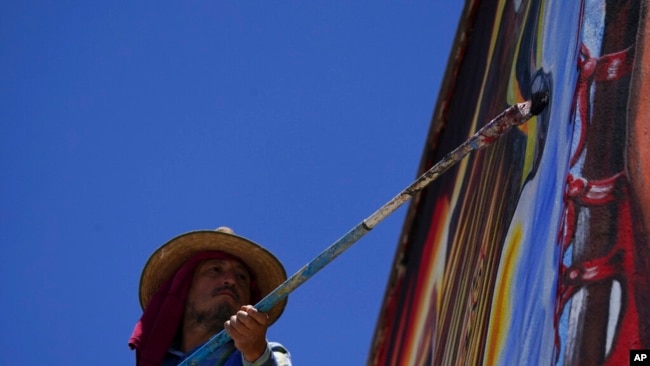
멕시코 예술가 Jesus Rodriguez는 7월 멕시코 산살바도르에 있는 강당의 정면에 그가 그리고 있는 벽화에 마지막 손질을 하고 있습니다.
Mexican artist Jesus Rodriguez paints the finishing touches on a mural he is painting on the facade of an auditorium in San Salvador, Mexico, July 30, 2022.
멕시코 정치 지도자들의 지원에도 불구하고, 그들의 작품은 그 나라 밖의 어떤 곳에서는 너무 도발적인 것으로 드러났습니다: 뉴욕의 록펠러 센터에 그려진 리베라 벽화는 공산주의를 미화했기 때문에 비난을 받고 철거되었습니다.
Despite the backing of Mexican political leaders, their work turned out to be too provocative in some places outside the country: A mural Rivera painted in New York's Rockefeller Center was censured and then demolished because it glorified communism.
우리는 좀 더 비겁합니다," 라고 태평양 연안 주 시날로아에 멕시코 최초의 벽화 대학 설립을 시도하고 있는 벽화가 에르네스토 리오스 로차(53)가 말했습니다. "우리는 평화에 대해 더 많이 이야기합니다.“
"We are a bit more cowardly," said Ernesto Ríos Rocha, 53, a muralist who is currently trying to found Mexico's first muralism university in the Pacific coast state of Sinaloa. "We talk more about peace."
그러나 오늘날 산살바도르와 다른 작은 마을에서 만들어지고 있는 벽화는 20세기 초에 만들어진 벽화와 여전히 많은 공통점이 있습니다. 이 책들은 전쟁, 부정, 억압의 주제뿐만 아니라 기후 변화와 여성에 대한 폭력과 같은 21세기 이슈들을 담고 있습니다.
The murals being created in San Salvador and other small towns today still have much in common with those created in the early 20th century, however: They encapsulate themes of war, injustice and oppression — as well as 21st century issues such as climate change and violence against women.
하지만 로드리게스와 그의 학생들은 그들의 작품에서 기념비적인 반향을 기대하지 않습니다. 그들의 열망은 더 낮고 수입은 더 적습니다. 대부분 벽화를 그리도록 의뢰하는 지방 자치 단체에서 왔고, 식사를 기부하고 외국인 학생들을 수용하는 지역사회 구성원의 지원을 받았습니다.
But Rodríguez and his students don't anticipate monumental reverberations from their work. Their aspirations are lower and their income more modest, coming mostly from local governments that commission them to paint murals and support from community members who donate meals and house foreign students.
Poxindeje 학교는 유리 제조업자나 바닥재 제조업자들이 기증한 폐기물을 재활용하고 재사용하는 것에 내기를 한다고 5년 전 Rodríguz와 함께 Siqueiros School을 공동 설립한 Janet Calderon은 말했습니다. 그들은 심지어 쓰레기로 벽화를 만듭니다.
The Poxindeje school bets on recycling and reusing discarded materials donated by glassmakers or flooring manufacturers, said Janet Calderón, who co-founded the Siqueiros School with Rodríguez five years ago. They're even making murals from garbage.
볼리비아 출신의 36세 조각가 루즈 아스투리자가는 벽화의 상징적인 고향에서 머무는 모든 순간을 즐겼습니다. 그녀는 전문 예술가들의 서클이 매우 폐쇄적이라고 말한 그녀의 나라에서 예술 형태에 대해 많은 것을 배울 수 없었습니다. 멕시코에서는 "그들은 여러분에게 기회를 주고, 여러분을 가르칩니다"라고 그녀는 말했습니다.
Luz Asturizaga, a 36-year-old sculptor from Bolivia, has enjoyed every moment of her stay in the iconic home of muralism. She wasn't able to learn much about the art form in her own country, where she said professional artists' circles are very closed. In Mexico, "they give you opportunity, they teach you," she said.
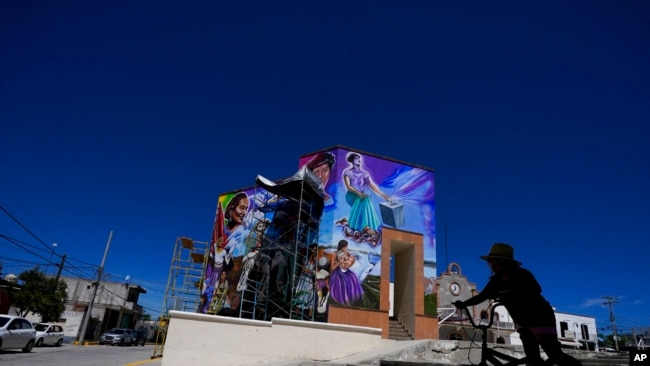
7월 멕시코 산살바도르에서 한 보행자가 멕시코 예술가인 Jesus Rodriguez에 의해 그려진 벽화 앞에서 자전거를 타고 있습니다.
A pedestrian rides her bike in front of a mural painted by Mexican artist Jesus Rodriguez, in San Salvador, Mexico, July 30, 2022.
5년 전 개교 이래 40여 명의 학생들이 이 학교에서 교육을 수료했지만, 모두 강사들이 주입한 명확한 아이디어를 가지고 떠납니다: "동네에 가서 가르치고, 역사적인 주제, 사회적 콘텐츠, 인간을 억압하는 모든 것에 대한 비판에 대한 포괄적인 작업을 수행하세요."라고 로드리게스는 말했습니다.
Few students have completed training at the school — about 40 since it opened five years ago — but all leave with clear ideas instilled by their instructors: "Go to the communities, teach, carry out a comprehensive work of historic themes, of social content, of criticism of everything that oppresses man," Rodríguez said.
예술가의 첫 번째 단계는 어떤 요소를 포함하고 싶은지, 어떤 은유를 배치할지를 결정하는 것입니다. 그리고 나서 그들은 그들이 영원히 간직하고 싶은 역사적 인물들의 초상화와 사진들의 콜라주를 만듭니다.
The first step for the artists is to decide what elements they want to include, what metaphors to lay out. Then they build a sort of collage of portraits and photographs of historical figures whom they want to immortalize.
구성과 관점이 핵심입니다. 물감이 얼룩진 청바지를 입고, 검은 머리를 포니테일로 묶은 54세의 로드리게스는 산살바도르에서 진행 중인 벽화 앞에서 한쪽 눈을 감고, 다른 쪽 눈에는 벽에 그려진 인물들의 스케치가 들어 있는 투명한 종이를 훑어봅니다. 목표는 사람들이 어디에서 어느 거리에서 작품을 보게 될지 고려하여 적절한 규모를 계산하는 것입니다.
Composition and perspective are key. Dressed in paint-splotched jeans, his black hair tied back in a ponytail, the 54-year-old Rodríguez closes one eye in front of the mural in progress in San Salvador, and with the other glances through a transparent sheet of paper containing sketches of figures intended for the wall. The goal is to calculate the right scale, taking into account from where and what distance people will be viewing the work.
여러분은 지역의 역사를 알고 나서 스케치부터 시작해야 합니다," 라고 벽화를 그리며 주말을 보내는 멕시코의 국영 석유 회사의 직원 루이스 마누엘 벨레즈(52)가 말했습니다.
"You have to know local history and then begin with the sketches," said Luis Manuel Vélez, 52, a worker for Mexico's national oil company who spends his weekends painting murals.
때때로 그 일을 위한 모델들이 이웃에서 옵니다. 산살바도르에 있는 벽화 옆을 지나던 6살 소녀가 가리키며 미소를 지으며 외쳤습니다: "저것은 저와 할아버지입니다."
Sometimes models for the work come from the neighborhood. A 6-year-old girl passing by the mural in San Salvador pointed and smiled before exclaiming: "That's me and my grandpa."
순수주의자들은 20세기 후반부터 벽화가 도시 예술이나 단명 낙서로 대체되었다고 오랫동안 한탄해 왔습니다.
Purists have long lamented that starting in the late 20th century, muralism was replaced by urban art or short-lived graffiti.
리오스로차는 동의하지만 여전히 낙관적입니다.
Ríos Rocha agrees but is still optimistic.
"뮤지컬리즘은 중환자실에 있지만, 죽지는 않을 것입니다," 라고 그가 말했습니다.
"Muralism is in intensive care, but it is not going to die," he said.
역사가 데이비드 마르티네스 부르제트는 88세의 벨라스 아르테스 박물관의 연구원으로 멕시코 시티의 궁전 같은 아르누보 공연 예술 센터 안에 리베라, 시케이로스, 오로스코의 유명한 벽화가 장식되어 있습니다.
Historian David Martínez Bourget is a researcher at the 88-year-old Bellas Artes Museum, a palatial art nouveau performing arts center in Mexico City whose interior walls are graced with famous murals by Rivera, Siqueiros and Orozco.
마르티네스 부르제트는 벽화의 아버지들이 20세기에 시작한 예술 운동은 끝났지만, 그 정신은 폭스인데제와 산살바도르뿐만 아니라 미국 서부의 소외된 치카노 공동체와 멕시코 남부의 사파티스타 마을에도 남아 있다고 말했습니다. 두 곳 모두에서 공공 미술 전시물은 공동체의 역사와 반란을 포착한다고 그는 지적했습니다.
Martínez Bourget said the art movement that the fathers of muralism began in the 20th century is over, but its spirit remains — not just in Poxindeje and San Salvador — but also in marginalized Chicano communities in the western United States and in Zapatista villages in southern Mexico. In both places, public art displays capture the communities' history and rebellion, he noted.
사람들이 사회 정의를 위해 싸우는 한, 이런 종류의 예술적 표현은 존재할 것이라고 마르티네스 부르제 씨는 말합니다. 왜냐하면 어려운 순간에는 "예술은 정치화됩니다."
As long as people are fighting for social justice, this kind of artistic expression will exist, Martínez Bourget says, because in difficult moments "art is politicized."
출처 : VOANews
댓글목록 0
등록된 댓글이 없습니다.




